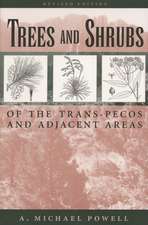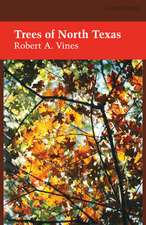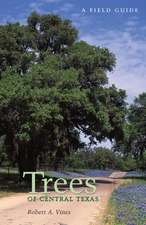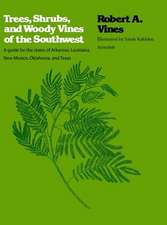Trees of East Texas
Autor Robert A. Vinesen Limba Engleză Paperback – iul 1977
Trees of East Texas is drawn from Robert A. Vines' monumental Trees, Shrubs, and Woody Vines of the Southwest (University of Texas Press, 1960). Without sacrificing the essential detail of the original work, this guide has been designed to travel info the field for on-the-spot identification. Meant to be carried and consulted, Trees of East Texas is conveniently organized, and virtually every description is accompanied by a finely executed illustration.
This book contains new and updated information, and every native and naturalized tree in the area is identified. In addition to the technical descriptions, the author provides, in his "Remarks" sections, common names and fascinating bits of history and lore on each tree cited.
Preț: 393.45 lei
Nou
Puncte Express: 590
Preț estimativ în valută:
75.31€ • 78.32$ • 63.11£
75.31€ • 78.32$ • 63.11£
Carte tipărită la comandă
Livrare economică 13-27 martie
Preluare comenzi: 021 569.72.76
Specificații
ISBN-13: 9780292780170
ISBN-10: 0292780176
Pagini: 556
Dimensiuni: 152 x 229 x 15 mm
Greutate: 0.45 kg
Editura: University of Texas Press
Colecția University of Texas Press
ISBN-10: 0292780176
Pagini: 556
Dimensiuni: 152 x 229 x 15 mm
Greutate: 0.45 kg
Editura: University of Texas Press
Colecția University of Texas Press
Notă biografică
The late Robert A. Vines served as director of the Houston Arboretum and Botanical Garden and of the Robert A. Vines Environmental Science Center of the Spring Branch Independent School District in Houston.
Cuprins
- Acknowledgments
- Introduction
- Taxodiium Family (Taxodiaceae)
- Pine Family (Pinaceae)
- Cypress Family (Cupressaceae)
- Palm Family (Palmae)
- Lily Family (Liliaceae)
- Willow Family (Salicaceae)
- Wax-myrtle Family (Myricaceae)
- Corkwood Family (Leitneriaceae)
- Walnut Family (Juglandaceae)
- Birch Family (Betulaceae)
- Beech Family (Fagaceae)
- Elm Family (Ulmaceae)
- Mulberry Family (Moraceae)
- Magnolia Family (Magnoliaceae)
- Custard-apple Family (Annonaceae)
- Laurel Family (Lauraceae)
- Witch Hazel Family (Hamamelidaceae)
- Sycamore Family (Platanaceae)
- Rose Family (Rosaceae)
- Legume Family (Leguminosae)
- Subfamily Mimosoideae
- Subfamily Caesalpinioideae
- Subfamily Papilionoideae
- Rue Family (Rutaceae)
- Quassia Family (Simarubaceae)
- Mahogany Family (Meliaceae)
- Euphorbia Family (Euphorbiaceae)
- Sumac Family (Anacardiaceae)
- Titi Family (Cyrillaceae)
- Holly Family (Aquifoliaceae)
- Staff-tree Family (Celastraceae)
- Maple Family (Aceraceae)
- Buckeye Family (Hippocastanaceae)
- Soapberry Family (Sapindaceae)
- Buckthorn Family (Rhamnaceae)
- Linden Family (Tiliaceae)
- Mallow Family (Malvaceae)
- Chocolate Family (Sterculiaceae)
- Camellia Family (Theaceae)
- St. John’s-wort Family (Hypericaceae)
- Tamarisk Family (Tamaricaceae)
- Flacourtia Family (Flacourtiaceae)
- Papaya Family (Caricaceae)
- Cactus Family (Cactaceae)
- Loosestrife Family (Lythraceae)
- Pomegranate Family (Punicaceae)
- Myrtle Family (Myrtaceae)
- Ginseng Family (Araliaceae)
- Dogwood Family (Cornaceae)
- Heath Family (Ericaceae)
- Sapodilla Family (Sapotaceae)
- Persimmon Family (Ebenaceae)
- Sweetleaf Family (Symplocaceae)
- Storax Family (Styracaceae)
- Ash Family (Oleaceae)
- Dogbane Family (Apocynaceae)
- Borage Family (Boraginaceae)
- Black Mangrove Family (Avicenniaceae)
- Verbena Family (Verbenaceae)
- Trumpet-creeper Family (Bignoniaceae)
- Madder Family (Rubiaceae)
- Honeysuckle Family (Caprifoliaceae)
- Diagrams of Flower Parts; Inflorescence; and Leaf Apices, Margins, and Forms
- Glossary
- Index
Descriere
This comprehensive and compact field guide covers the richest plant-life region in the state—the Upper Gulf Coast Prairie, the Post Oak Savannah, and the Pineywoods of east Texas.









